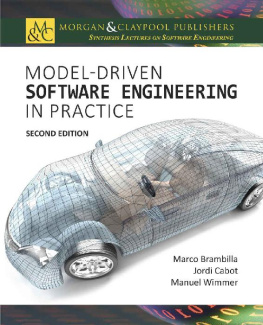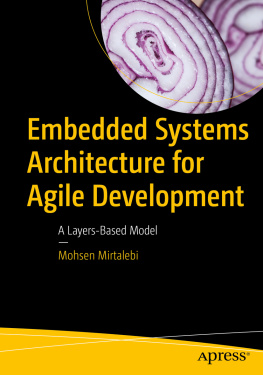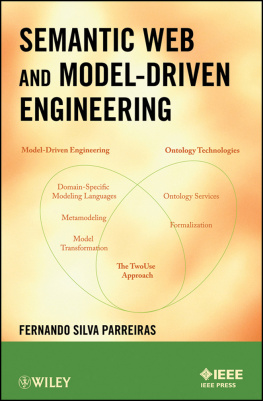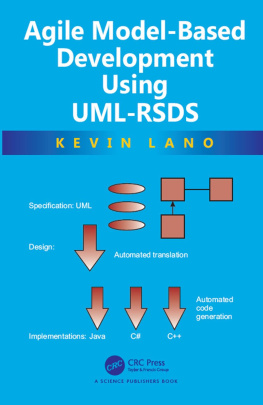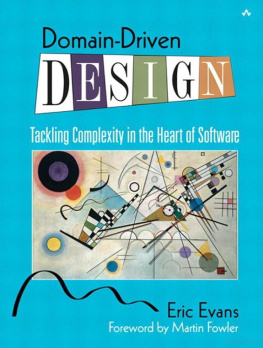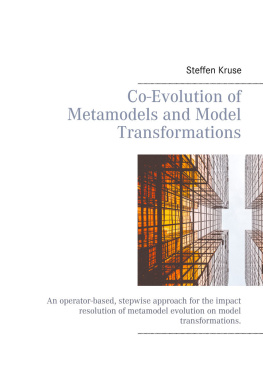Völter - Model-Driven Software Development
Here you can read online Völter - Model-Driven Software Development full text of the book (entire story) in english for free. Download pdf and epub, get meaning, cover and reviews about this ebook. City: Chichester, year: 2006;2013, publisher: John Wiley & Sons, Inc., genre: Computer. Description of the work, (preface) as well as reviews are available. Best literature library LitArk.com created for fans of good reading and offers a wide selection of genres:
Romance novel
Science fiction
Adventure
Detective
Science
History
Home and family
Prose
Art
Politics
Computer
Non-fiction
Religion
Business
Children
Humor
Choose a favorite category and find really read worthwhile books. Enjoy immersion in the world of imagination, feel the emotions of the characters or learn something new for yourself, make an fascinating discovery.

Model-Driven Software Development: summary, description and annotation
We offer to read an annotation, description, summary or preface (depends on what the author of the book "Model-Driven Software Development" wrote himself). If you haven't found the necessary information about the book — write in the comments, we will try to find it.
Völter: author's other books
Who wrote Model-Driven Software Development? Find out the surname, the name of the author of the book and a list of all author's works by series.
Model-Driven Software Development — read online for free the complete book (whole text) full work
Below is the text of the book, divided by pages. System saving the place of the last page read, allows you to conveniently read the book "Model-Driven Software Development" online for free, without having to search again every time where you left off. Put a bookmark, and you can go to the page where you finished reading at any time.
Font size:
Interval:
Bookmark:

Model-Driven Software Development

Copyright 2006 John Wiley & Sons Ltd, The Atrium, Southern Gate, Chichester, West Sussex PO19 8SQ, England
Telephone (+44) 1243 779777
Email (for orders and customer service enquiries):
Visit our Home Page on www.wiley.com
All Rights Reserved. No part of this publication may be reproduced, stored in a retrieval system or transmitted in any form or by any means, electronic, mechanical, photocopying, recording, scanning or otherwise, except under the terms of the Copyright, Designs and Patents Act 1988 or under the terms of a licence issued by the Copyright Licensing Agency Ltd, 90 Tottenham Court Road, London W1T 4LP, UK, without the permission in writing of the Publisher. Requests to the Publisher should be addressed to the Permissions Department, John Wiley & Sons Ltd, The Atrium, Southern Gate, Chichester, West Sussex PO19 8SQ, England, or emailed to , or faxed to (+44) 1243 770620.
Designations used by companies to distinguish their products are often claimed as trademarks. All brand names and product names used in this book are trade names, service marks, trademarks or registered trademarks of their respective owners. The Publisher is not associated with any product or vendor mentioned in this book.
This publication is designed to provide accurate and authoritative information in regard to the subject matter covered. It is sold on the understanding that the Publisher is not engaged in rendering professional services. If professional advice or other expert assistance is required, the services of a competent professional should be sought.
Other Wiley Editorial Offices
John Wiley & Sons Inc., 111 River Street, Hoboken, NJ 07030, USA
Jossey-Bass, 989 Market Street, San Francisco, CA 94103-1741, USA
Wiley-VCH Verlag GmbH, Boschstr. 12, D-69469 Weinheim, Germany
John Wiley & Sons Australia Ltd, 33 Park Road, Milton, Queensland 4064, Australia
John Wiley & Sons (Asia) Pte Ltd, 2 Clementi Loop #02-01, Jin Xing Distripark, Singapore 129809
John Wiley & Sons Canada Ltd, 22 Worcester Road, Etobicoke, Ontario, Canada M9W 1L1
Wiley also publishes its books in a variety of electronic formats. Some content that appears in print may not be available in electronic books.
Library of Congress Cataloging-in-Publication Data
Stahl, Thomas (Tom)
Model-driven software development : technology, engineering, management / Thomas Stahl and Markus Vlter, with Jorn Bettin, Arno Haase, and Simon Helsen ; foreword by Krzysztof Czarnecki ; translated by Bettina von Stockfleth.
p.cm.
Includes bibliographical references and index.
ISBN 0-470-02570-0 (pbk. : alk. paper)
1. Computer softwareDevelopment. I. Vlter, Markus. II. Title.
QA76.76.D47S697 2006
005.1dc22
2006007375
British Library Cataloguing in Publication Data
A catalogue record for this book is available from the British Library
ISBN-13: 978-0-470-02570-3
ISBN-10: 0-470-02570-0
Foreword
by Krzysztof Czarnecki
Modeling is a key tool in engineering. Engineers routinely create models when analyzing and designing complex systems. Models are abstractions of a system and its environment. They allow engineers to address their concerns about the system effectively, such as answering particular questions or devising required design changes. Every model is created for a purpose. A particular model may be appropriate for answering a specific class of questions, where the answers to those questions will be the same for the model as for the actual system, but it may not be appropriate for answering another class of questions. Models are also cheaper to build than the real system. For example, civil engineers create static and dynamic structural models of bridges to check structural safety, since modeling is certainly cheaper and more effective than building real bridges to see under what scenarios they will collapse.
Models are not new in software development. Over the past few decades, the software industry has seen numerous analysis and design methods, each with its own modeling approaches and notations. More recently, we have witnessed the remarkable progress of Unified Modeling Language (UML), which now has a larger market penetration than any single previous modeling notation. Still, analysis and design models rarely enjoy the same status as code. The reality of most software projects is that models are not kept up-to-date with the code, and therefore they become obsolete and useless with time.
Model-Driven Software Development (MDSD) puts analysis and design models on par with code. Better integration of such models and code should significantly increase the opportunity to effect change through the models, rather than simply modifying the code directly. MDSD encompasses many different techniques across the entire spectrum of software development activities, including model-driven requirements engineering, model-driven design, code generation from models, model-driven testing, model-driven software evolution, and more.
The Model-Driven Architecture (MDA) initiative by the Object Management Group (OMG) has also certainly contributed a great deal to the recent surge of interest in software modeling and model-driven techniques. But the effects of that initiative have been both good and bad. On the positive side, Im glad that modeling has been moved into the center of interest and that organizations are now trying to figure out how their current practices can be leveraged through model-driven techniques. At the same time, the marketing hype around MDA has tended to create some unrealistic expectations. Putting all this hype aside, I do think that MDSD has great ideas to offer, many of which can be put to work in practical situations today. Realizing these potentials requires a solid understanding of current MDSD technology, its applicability, and its limitations.
The authors of this book are at the forefront of MDSD research and practice. Markus and Jorn have organized and participated in a series of MDSD workshops at several OOPSLA conferences. Simon has participated in OMGs standardization efforts on model transformation. All the authors are pioneering this technology in practice in several domains, ranging from enterprise applications to embedded software in both small and large organizations, such as b+m, Siemens, and BMW.
Im very pleased to introduce this book to you. In my view, this is one of the rare books in the model-driven space that talks not only about the vision, but also about what is possible today, and how to do it. After a minimal but necessary dose of basic concepts and terminology, the authors cover a wide range of MDSD technology topics such as metamodeling, component architectures and composition, code generation, model transformation, MDA standards, and MDSD tools. I particularly like the hands-on approach that the authors have taken. They illustrate available tools and techniques through concrete modeling examples and code snippets, and they give numerous practical tips and mind-the-gap hints. In addition to the technology topics, the authors also present a comprehensive treatment of essential software engineering aspects such as testing, versioning, process management, and adoption strategies, as they apply to MDSD. The content is topped off with two case studies, that were inspired by realistic applications from the authors collective experiences.
The authors present a broad perspective of MDSD that goes beyond MDA to cover a range of related approaches including software product lines, domain-specific languages, software factories, and aspect-oriented and generative programming. As in any young, dynamic, and still evolving field, the abundance of competing ideas, concepts, and parallel terminologies in todays model-driven space can be bewildering. As a result, the authors had to do a lot of sifting through the mud to give us a clear and balanced picture of the entire model-driven field. In this book, they have done just that, tremendously well.
Font size:
Interval:
Bookmark:
Similar books «Model-Driven Software Development»
Look at similar books to Model-Driven Software Development. We have selected literature similar in name and meaning in the hope of providing readers with more options to find new, interesting, not yet read works.
Discussion, reviews of the book Model-Driven Software Development and just readers' own opinions. Leave your comments, write what you think about the work, its meaning or the main characters. Specify what exactly you liked and what you didn't like, and why you think so.

